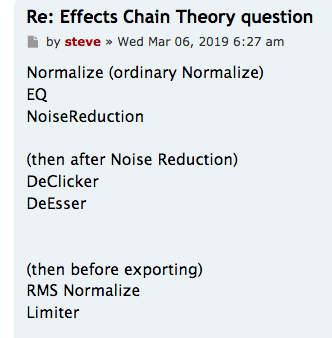This is the single message part of a larger posting.

Which is here.
https://forum.audacityteam.org/t/effects-chain-theory-question/52107/4
Ordinary Normalize is just a volume booster and should be applied with the Remove DC option selected. That boosts your work to (default) maximum so you can see the blue waves while you’re trying to edit them. It has no processing other than that. DC Removal guards against hardware problems of your microphone, mixer or interface, inaudible, but can cause editing problems.
Following that is EQ or Effect > Equalization, and not just any Equalization. Use Low Rolloff for Speech at about 5000 length. This gets rid of more acoustic rumble and sub-sonic trash.
We part company on Noise Reduction next mostly because until you get closer to the end, you have no idea how much Noise Reduction you will need…if any. Too much Noise Reduction is audible.
This is where you edit your brains out, cutting out fluffs, deleting bad passages and sentences.
DeClicker and DeEsser are used, in general, when you have a home-style microphone trying to be “professional” by boosting the crispness of your presentation. This also has the effect of making every single little mouth imperfection, smack and tick immediately obvious and disturbing. There was a recent ACX recommendation to please stop using home style Condenser Microphones so submission sound will stop doing that. Dynamics are good.
The next two, RMS Normalize and Limiter, are the final steps in the regular ACX Audiobook Mastering found here.
https://wiki.audacityteam.org/wiki/Audiobook_Mastering
Those guarantee RMS and Peak, two of the three audioboopk specifications.
If you read at good volume with a well-behaved microphone in a quiet room, you can read, edit and skip directly to Audiobook Mastering. If you really did a good job, you won’t need noise reduction at all, or any of those other tools.
This is part of a much larger Recommended Practices and AudioBook Mastering book I’m going to wrote … one of these days.
Koz